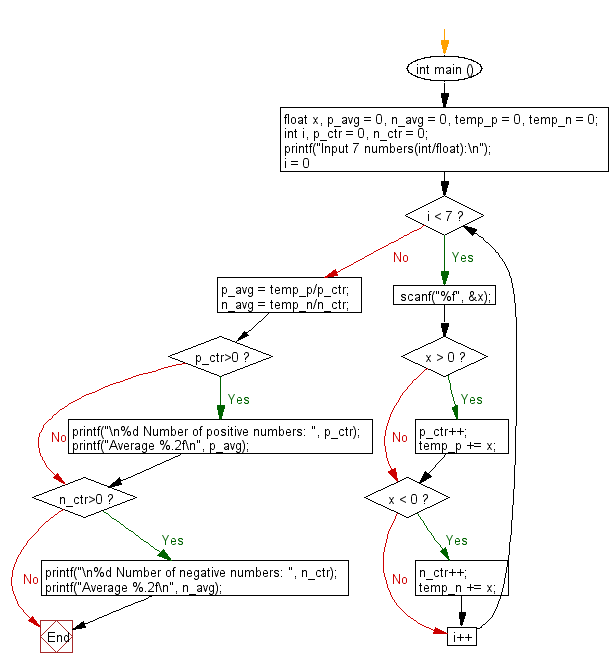C Exercises: Count and compute positive, negative numbers and average with two digits after the decimal number
C Basic Declarations and Expressions: Exercise-105 with Solution
Write a C program that accepts seven floating point numbers and count the number of positive and negative numbers. Also print the average of all positive and negative values with two digit after the decimal number.
Sample Solution:
C Code:
#include <stdio.h>
int main () {
float x, p_avg = 0, n_avg = 0, temp_p = 0, temp_n = 0;
int i, p_ctr = 0, n_ctr = 0;
printf("Input 7 numbers(int/float):\n");
for (i = 0; i < 7; i++){
scanf("%f", &x);
if (x > 0)
{
p_ctr++;
temp_p += x;
}
if (x < 0
) {
n_ctr++;
temp_n += x;
}
}
p_avg = temp_p/p_ctr;
n_avg = temp_n/n_ctr;
if (p_ctr>0)
{
printf("\n%d Number of positive numbers: ", p_ctr);
printf("Average %.2f\n", p_avg);
}
if (n_ctr>0)
{
printf("\n%d Number of negative numbers: ", n_ctr);
printf("Average %.2f\n", n_avg);
}
}
Sample Output:
Input 7 numbers(int/float): 25 35.75 15 -3.5 40 35 16 6 Number of positive numbers: Average 27.79 1 Number of negative numbers: Average -3.50
Flowchart:

C programming Code Editor:
Contribute your code and comments through Disqus.
Previous: Write a C program that read the item's price and create new item price and increased price of that item according to the item price table.
Next: Write a C program that accepts 7 integer values and count the even, odd, positive and negative values.
What is the difficulty level of this exercise?
Test your Programming skills with w3resource's quiz.
C Programming: Tips of the Day
Static variable inside of a function in C
The scope of variable is where the variable name can be seen. Here, x is visible only inside function foo().
The lifetime of a variable is the period over which it exists. If x were defined without the keyword static, the lifetime would be from the entry into foo() to the return from foo(); so it would be re-initialized to 5 on every call.
The keyword static acts to extend the lifetime of a variable to the lifetime of the programme; e.g. initialization occurs once and once only and then the variable retains its value - whatever it has come to be - over all future calls to foo().
Ref : https://bit.ly/3fOq7XP
- New Content published on w3resource:
- HTML-CSS Practical: Exercises, Practice, Solution
- Java Regular Expression: Exercises, Practice, Solution
- Scala Programming Exercises, Practice, Solution
- Python Itertools exercises
- Python Numpy exercises
- Python GeoPy Package exercises
- Python Pandas exercises
- Python nltk exercises
- Python BeautifulSoup exercises
- Form Template
- Composer - PHP Package Manager
- PHPUnit - PHP Testing
- Laravel - PHP Framework
- Angular - JavaScript Framework
- Vue - JavaScript Framework
- Jest - JavaScript Testing Framework
